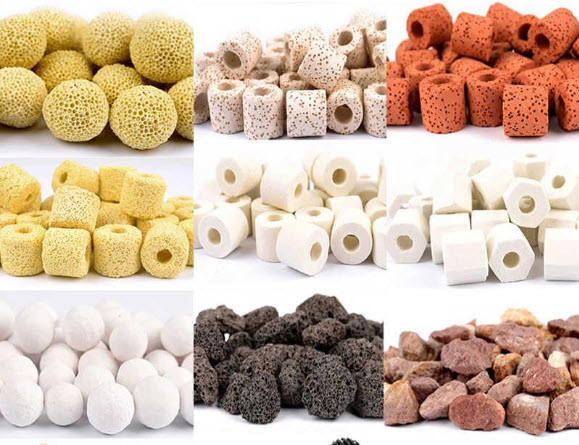
There is a huge amount of misinformation out there about the efficacy of ceramic media. Ceramics are NOT good media for aquarium filters. They have the following shortcomings:
- Low effective surface area which gives poor biofiltration
- Shed small abrasive particles which take out pumps
- Do not do any denitrification
- Very high cost
Ceramic media like Matrix and Biohome have a huge amount of false marketing hype and snake oil salesmanship. It is all false. Ceramics do NOT have huge amounts of beneficial bacteria living inside them. We go into the reason behind that in great length below. Only hobbyists who are nerds like the author need to read on. This is VERY long and boring.
Types of Ceramic Media
There are a huge number of ceramic filter media available:

These ceramic media are marketed under a host of names such as Top Fin Quartz Bio Balls, Siporax and Biomax. They are largely all the same. They are all just porous sintered clay ceramics or glass.
Biohome
Another ceramic product which is the same as all the others is Biohome. This ceramic media is heavily marketed by a YouTube guru called the “Pondguru” from the United Kingdom. If I want a laugh I watch this snake oil salesman’s videos.
The videos are all about how there is a very exact mix of sand, clay, sintered glass and “tiny amounts” of “special, very expensive, trace elements and minerals” that make the Biohome product capable of both doing huge amounts of aerobic oxidation of ammonia to nitrate AND doing anaerobic reduction of nitrates to nitrogen gas. LOL When pigs fly.
Just think about the fact that aerobic (“with oxygen”) and anaerobic (“without oxygen”) are diametrical opposites. And oxidation and reduction are diametrical opposites. This media, according to the Pondguru, does great jobs with both processes in the same media. HHHhhhmmmmmm…..

It is fun to watch this snake oil salesman go on and on about “natural processes” and how his product has taken “years of research” to create a “tremendous product”. Don’t believe a single thing the Pondguru says. He is the originator and chief distributor of Biohome. He makes a HUGE profit on every single pound of Biohome sold.
Biohome is a very cheap to manufacture media sold at ridiculous prices and generating ridiculous profit margins for the Pondguru. Biohome is not a good media for aerobic ammonia oxidation as shown by testing that is outlined below. Biohome also does not do any anaerobic decomposition of nitrate to nitrogen gas, again proven by actual controlled testing. We prove this anaerobic claim to be pure marketing hype by controlled testing in this link:
7.5. Test of Denitrifying Media
Aflagrog
One unique ceramic material is widely used in the United Kingdom. It is called Aflagrog. It has a greater effective surface area than ceramic rings and balls due to it’s contorted surface. This media was a surprise in that it was the only ceramic media which gave crystal clear water in testing. The contorted surface does appear to make this product significantly better than other ceramics.

When a British Facebook aquarium forum member asked about Alfagrog I though she was talking about beer. LOL.
Ceramic Media Efficacy
Porous ceramic rings, balls, cylinders and noodles and porous glass are heavily marketed but are not nearly as effective as claimed. Specifically, the problem has to do with the word “porous”. The pores in the ceramic have several obvious problems:
- The pore surface area being measured by the manufacturers is far too small for bacteria to fit into.
- A highly “porous” media with small pores is a media which will not allow ANY flow of water through the media, even when the media is new. The water flows around the media, not through the media. The water must flow through the media for it to be effective.
- The pores that do exist on the ceramic surfaces that are large enough for a bacteria to get into, clog up rapidly with bacteria in any biological system.
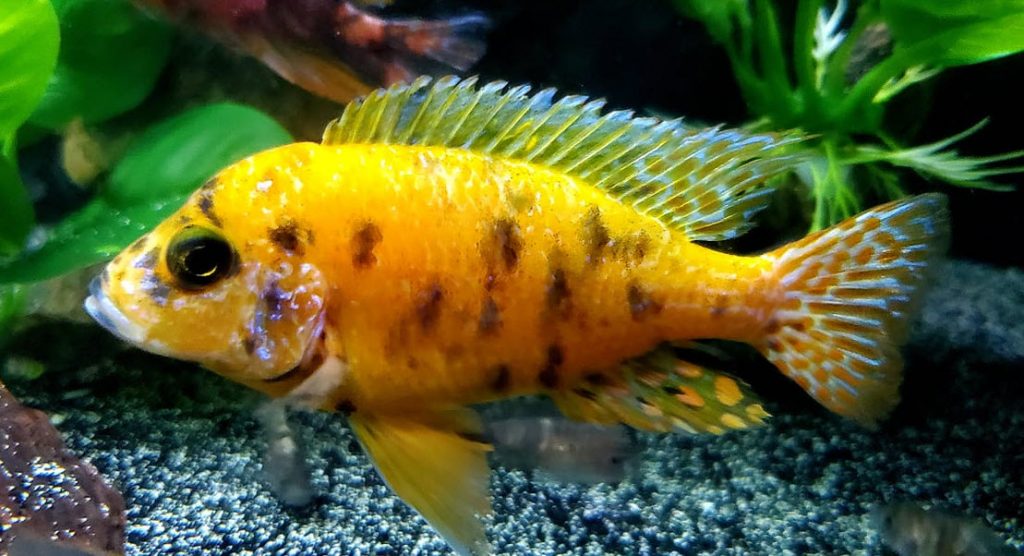
The one constant with ceramic media is that they all claim to culture lots of very beneficial bacteria inside the media. The author has had a lot of different ceramic media in canisters and sumps for many, many years (like twenty to forty years!). Several types of ceramic media were broken apart and examined.
Old beneficial bacteria are brown in color. If there were beneficial bacteria growing inside ceramic media these should be a brown stain inside the media. All the different white and cream ceramic media, rings and balls, were all totally sterile and white inside whilst covered with brown bacteria on ONLY their outside surface. There was some gray BioHome and some Matrix which were gray and sterile inside when broken apart. None of the media had any brown or yellow color inside the media. So NO beneficial bacteria were growing inside these ceramic medias. NONE!
Surface Area of Ceramic Media
The surface areas claimed for these media are huge. To give you some idea of the incredible marketing hype surrounding ceramic media the following are the manufacturers’ claims of surface area
- Matrix 213,416 ft2/ft3
- BioHome 173,809 ft2/ft3 (7,300 sq. ft/kilo)
- MarinePure Spheres 127,680 ft2/ft3
- Ehiem Substrate pro 42,784 ft2/ft3
- Biomax Ceramic Rings 20,000 ft2/ft3
- Sintered Glass Rings 19,000 ft2/ft3
All these products have roughly 15 to 40 ft2/ft3 of EFFECTIVE surface area. How’s that for marketing hype?
A typical marketing hype is the following:
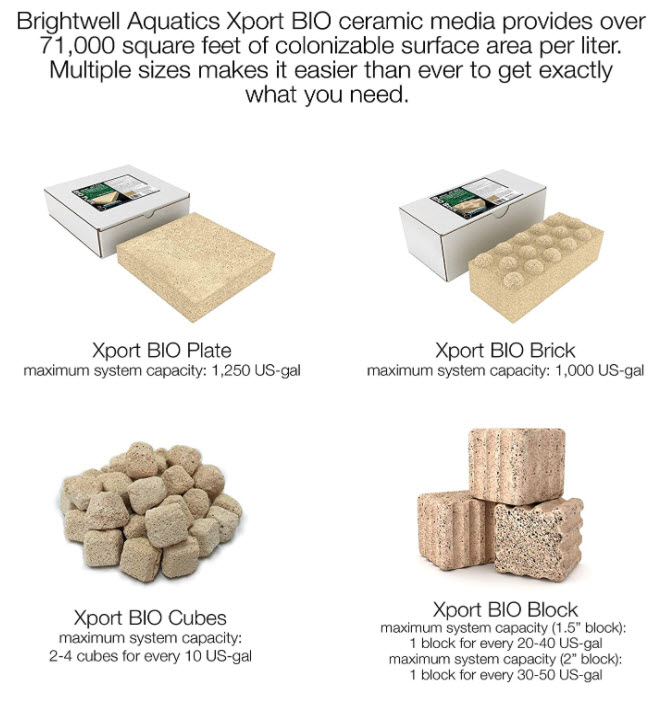
This media is simply very expensive crap that will NOT work. Sorry, I couldn’t come up with a nice way to say that. But there are people out there who will buy this because “suppliers never lie”.
I would ask all these people to contact me in the message section on the Home Page. I have a pill I want to sell them. It is guaranteed to raise one’s IQ twenty points, subtract 20 years from your apparent age, and make you irresistible to the opposite sex. It is only $998 per pill. Oh, and ignore the letters B-A-Y-E-R on the pills.
How the Manufacturers “Test” Media
The surface area claimed by most ceramic media manufacturers is based on how much nitrogen gas can penetrate the media and adsorb on the surface via something called a pycnometer via a complex calculation called the BET equation. This test doesn’t even come close to reflecting reality in the aquarium.
The nitrogen gas molecule is billions of times smaller than a beneficial bacterial cell. Depending on the ceramic process used, the pore size in ceramic media can be as low as 0.001 microns in size. The ceramic media claiming the highest surface area have the smallest pore sizes. A bacterium is 2 to 5 microns in size.
So, the nitrogen gas is adsorbed in billions of tiny pores where bacteria can’t even fit. As a result, all the manufacturers surface area claims which are based on the BET nitrogen infusion test are simply bogus. They are pure unadulterated marketing hype.
This total lack of reality is shown by the Alfagrog claims.

In actuality if one looks at EFFECTIVE surface area rather than nitrogen gas infusion area, the chart give the red bars below:

This is a MUCH different story! Note I do not know what they meant by “plastic coils”.
Water Flow
The small pore size also creates problems even for large pores like 2 millimeter (0.040 inches). The water flows through the path of least resistance. The water will not flow though small 2 millimeter pores if the water can flow around the media. In order for nitrifying (ammonia oxidizing) beneficial bacteria to work there has to be a high flow over the surface of the bacteria. The beneficial bacteria need contact with thousands of molecules of ammonia or nitrite in order to metabolize and grow.
When there is only a low flow the beneficial bacteria don’t contact the necessary number of molecules of ammonia or nitrite and thus can’t metabolize ammonia to nitrate.
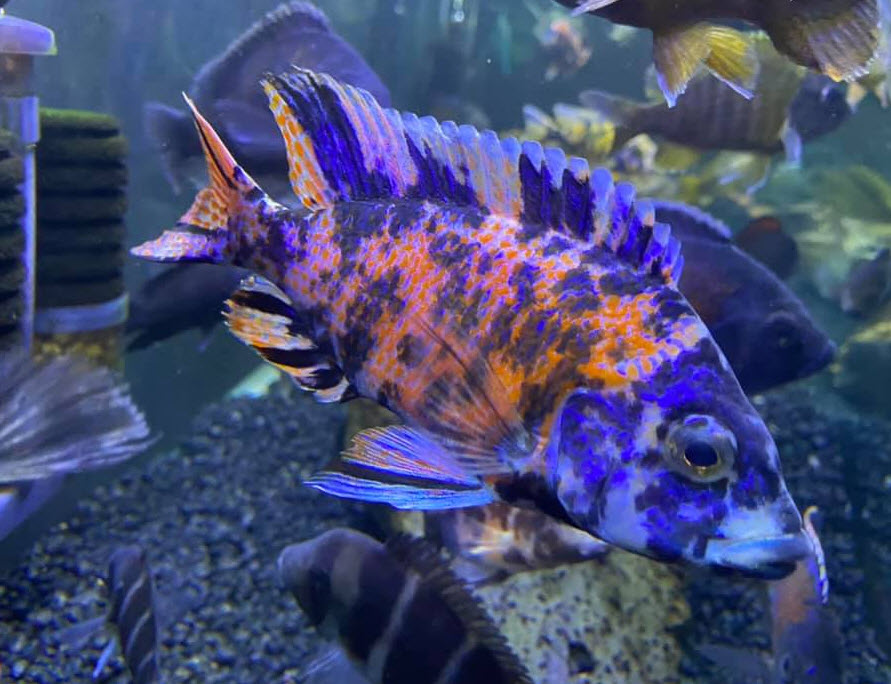
Clogging of Pores
And the “porous” ceramic media, fused glass and natural stone have a problem even for pores larger than a bacterium. Nitrifying bacteria live inside a biofilm (which they create) and that has a thickness of around 50-300 microns (let’s say 200 microns average). So, a round pore inhabited by nitrifying bacteria is coated on all its internal surface by this film.
Which means that is a diameter of around 400 microns (almost half a millimeter) is occupied by bacterial biofilm. And then, enough space needs to remain for a good water flow through it. This means that a single pore needs to be larger than at least one millimeter (two is even better) in order to be efficiently occupied by nitrifying bacteria.
Also, let’s say a ceramic media with a large surface area will have a pore size on the order of 30 microns (one thousandths of an inch). A bacterium is 2 to 5 microns in size. So, a bacterium only must divide a few times to clog a passageway into some ceramic media. Bacteria can multiple every 30 minutes. Think about that for a while. The pores are just too small. They clog far too rapidly.
So the effective surface area of all media becomes the surface area over which water flows, not the surface area that nitrogen gas can somehow find its way to. This is what was calculated in the table at the top of the page, 20 to 40 ft3/ft3.

A Test of Ceramic Media
A test of ammonia oxidizing capability of various filter media was run. The first number, the “efficiency” is the average ammonia oxidizing that 15 cubic inches of media accomplished over a 90-day period. The second number is the “effective” surface area in square feet per cubic feet calculated from that test. The third number is the effective surface area in square feet per cubic feet calculated by simple mathematics. The correlation between the test results and the calculated surface area is very significant and means the testing was accurate.

The higher the numbers here the better the media. This makes 30 ppi foam the best media and ceramic rings the worst media. Any ceramic media will have results somewhere between lava rock and the ceramic rings.
The details of this test can be found at this link:
7.1.3. Test of Filter Media
.

Ceramic Blocks
One very bad media to use is large porous ceramic blocks. These large ceramic blocks are very high-priced items ($52 for a single 8x8x4 block!) with extremely low effective surface areas of about 2 to 10 ft2/ft3. Some very popular YouTube gurus use them in their sumps. There are several problems with these blocks:
- In order for beneficial bacterial biofilms to remove ammonia and other compounds from the water the water must flow across the biofilm. The faster the flow the better. There is virtually no flow at all through these blocks if they are submerged in water. The water flows through the easiest path, which is around, not through the blocks. The water only diffuses slowly into the top few millimeters.
- The pore size is too small on these blocks. The beneficial bacteria will quickly plug the surface of these blocks and prevent even a small flow of water into the blocks.
- The lack of flow inside the blocks also means that these blocks do not do any anaerobic reduction of nitrate to nitrogen gas. This was confirmed by year long testing of the blocks. This testing can be found in this link:
7.5. Test of Denitrifying Media
If water were forced through the blocks they would be a decent but short lived media. Since water must passively diffuse in and out of the blocks to be effective they don’t work very well. The effective diffusion zone where water will diffuse in and out in a few days is on the order of 1/8 to ¼ inch. You might as well use a common brick, it would function almost as well and is much cheaper.
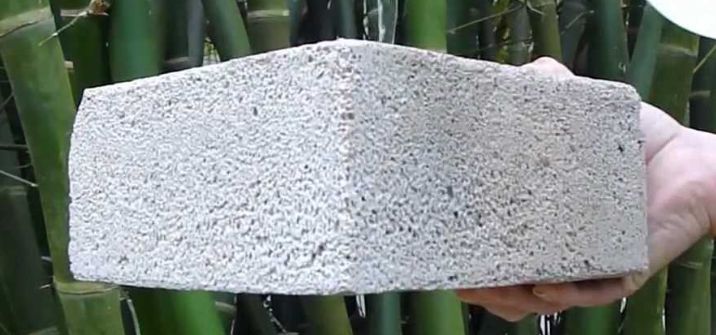
A very similar scam is the EcoBio-Stone;
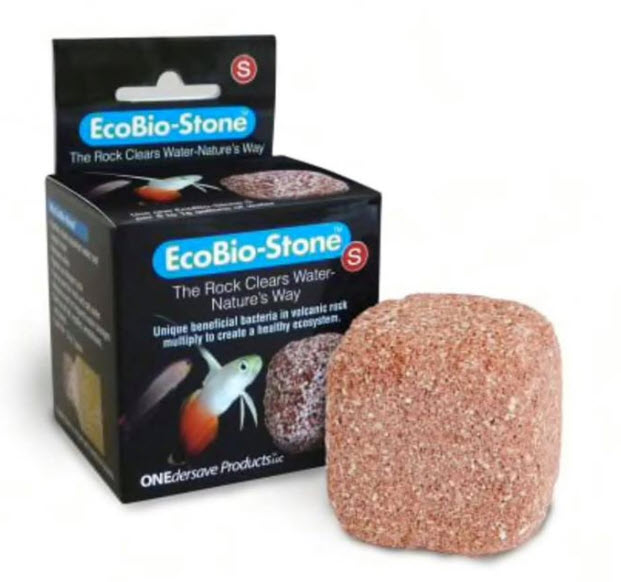
The “EcoBio-Stone” makes the scam even worse by claiming it has “unique beneficial bacteria”. It is all pure marketing snake oil. This block is a very cheap to manufacture worthless product which is sold at a very high price, giving a HUGE profit margin.
Almost as bad as the ceramic blocks are the Aquaneat columns. They have all the shortcomings of the Cermedia blocks with only a small improvement in effective surface area:

.
Lightweight Ceramic Media
An even worse media is the lightweight ceramic media like the balls below. This media looks attractive. It has a structure very much like a 40 to 60 ppi urethane foam, which would be great for biofiltration if the flow went THROUGH the media. But the flow is around the media, meaning this does very poor biofiltration.
Also the ceramic is only strong if it is dense. Lightweight ceramic media crushes and decomposes rapidly, creating huge problems with pumps. Avoid any form of lightweight ceramic media unless you like replacing pump impellers every few months. And the media will be gone in a year.

The Fluval BioFX media is just such a porous ceramic media. An exchange in the comment section of this website is pertinent:
Cody
Have you seen the new Fluval BioFx media? I found it interesting that this new bio-media closely resembles a sponge in its pore structure. I’ve been using Poret foam per your advice with great success. Curious how this BioFX ceramic “foam” media would perform compared to other forms of traditional ceramic media.
Dave
In reply to Cody … The Fluval BioFX is very bad media. First off the pores will quickly clog, like in days. Secondly, the water flow will be around the media, not through it. And, thirdly, this type of porous ceramic media gradually reduces to tiny abrasive particles which wreak havoc with pumps. While the “surface area” that an incredibly tiny nitrogen molecule can access in this media is very high, like many thousands of square meters per cubic meter, the “effective surface area” where nitrifying bacteria can colonize is about 30 square feet per cubic foot (90 square meters per cubic meter), i.e. very low and very bad, just like any other ceramic media.
AndrewK
Dave: I watched one of the official videos for Fluval BioFX and read official replies to queries. Thought you would find this amusing:
Question: “Anonymous” [lol] asks whether BioFX will “reduce nitrates like Seachem matrix?”
Answer: “No, it won’t, and neither will Matrix – it’s biologically impossible to have aerobic and anaerobic conditions within individual pieces of filter media!”
Question: “Why does BioFX (a ceramic media) need replacing every 6 months?
Answer: “Over time, the pore structure of biological media can become clogged with debris and as such cannot be colonized by nitrifying bacteria species .. so replace half of the biological media every six months,
BioFX has 2,250 square meters of surface area per liter of media!
The varying tunnel sizes of BioFX allow for a wide variety of bacteria species, making it superior to other media which don’t have varying tunnel sizes and therefore don’t grow different bacteria species, and therefore have inferior filtration.”
Lol. So, serve up some truth sauce to poison your competitor, a soupcon of self-interested spices to justify ordering desserts with your entrée, then sprinkle with “pseudoscientific bedazzlement.”
Love it. AndrewK
I thought all might enjoy this exchange. I found it amusing.
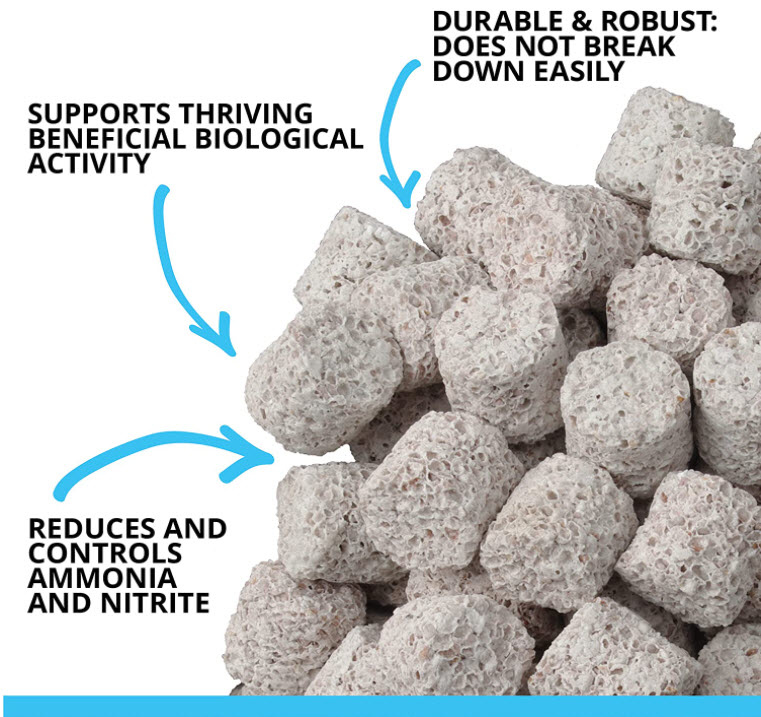
An Exception
There is one exception to the unsuitability of ceramics. If you are an obsessive-compulsive clean freak who absolutely must thoroughly clean your biomedia of the “horrid gunk” covering it on a frequent basis (more than once a year!), then ceramic, sintered glass, lava rock and pumice have an advantage. The larger surface pores in this material will protect some beneficial bacteria from the cleaning.
Plastic media have a very smooth surface which can be cleaned rather thoroughly by a determined obsessive-compulsive person. So, the many plastic media are at a disadvantage in this instance.
Nitrate Removal
There are two ceramic media which claim to reduce nitrate to nitrogen gas. This is Biohome and Matrix (actually a form of Matrix called “De*Nitrate”). Testing showed these material did not do any reduction of nitrate to nitrogen gas. This testing can be found in this link:
7.5. Test of Denitrifying Media
.
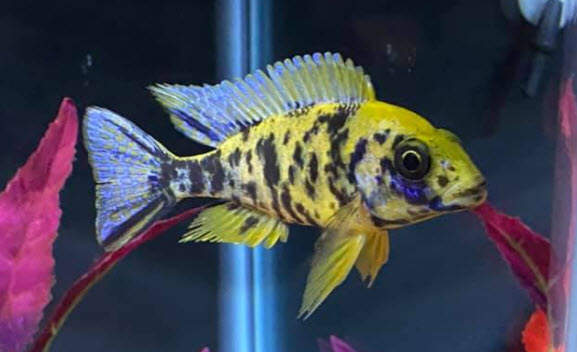
Belief Perseverance Effect
Social media response has shown that many, many hobbyists who read this analysis that have ceramic media or blocks in their filters will simply reject the above testing and analysis. This is something called “belief perseverance effect”. It says that when we buy something, especially if we pay a lot of money for that something, even when presented with evidence we made our purchase in error, we tend to rationalize and support our decision. Logic and science will often have little effect on such beliefs.
.
“Nothing dies harder than a lie that people want to believe” Calvin
.
Now ignoring the science and embracing these products will probably not kill one’s fish. They will only result in what is the unnecessary expenditure of money. And the water might have some ammonia and in all probability the water will not be crystal clear. And water which is not crystal clear is unhealthy water. However if one believes in one or more of these products, have at it! In our society burning money is completely acceptable and “dull” water typically won’t kill the fish outright. “Dull” water just leaves a fish more open to disease.

At this point I will violate one of my self imposed “rules” and provide some anecdotal evidence. One reader of this website sent me the following experiment which they did:
“I have conducted the experiment for ammonia oxidizing speed in my Malawi tank. So initially I had Juwel Bioflow filter with ceramic rings in the biological block and in the Juwel filters. So in the initial configuration of my filtration, 0.5 ppm of ammonia was oxidized to zero in 4 hours. Then I have replaced all biomedia with HelX (K1 type media) and added some Micro K1 to the mechanical block. In 4 weeks the same 0.5 ppm of ammonia were oxidized in about 2.5 to 3 hours with a very severe fall of the ammonia levels in the first hour. So the replacement of a ceramics that was in a filter for years with K1/HelX has actually improved the speed of ammonia oxidation in just one month.”
HHHHhhhmmmmm………
Return to Filter Media Menu
Return to List of Media Menu
.
Aquarium Science Website
The chapters shown below or on the right side in maroon lead to close to 400 articles on all aspects of keeping a freshwater aquarium. These articles have NO links to profit making sites and are thus unbiased in their recommendations, unlike all the for-profit sites you will find with Google. Bookmark and browse!
.

Dave says
In reply to Jimmy …… 1, Moving bed bioreactor is always the superior way to go. 2, Standard K1 is the best media for MBBRs 3, It still won’t create an anoxic environment.
Jimmy says
Thanks for debunking the myth. I am in the process of expanding my koi pond from 10 cubic meters to 90 cubic meters and thankfully I read your articles here before investing any more ceramic stones into my 25 cubic meters filtration chamber!
I avoid using foam or matala mat because of the maintenance difficulty, but using K1 as you suggested looks promising. I have questions:
1. Since you test the K1 with static mode, will it be better if with MBBR?
2. I see that there are other MBBR carrier like biochip that may have higher SSA compare to K1. What do you think?
3. Just to reconfirm, so you think there is no way to intentionally remove nitrate from the system? How about putting foam or matala mat, never clean them and let the sludge accumulate? Maybe it will create anoxic environment?
Dave says
In reply to Dimitrije ….. There are six requirements for anoxic reduction of nitrate to nitrogen gas. SIX REQUIRED FEATURES!!!! So, while it MIGHT be POSSIBLE for a very organic ceramic substrate to get to an anoxic level, it is NOT POSSIBLE FOR THAT SUBSTRATE TO REDUCE NITRATE TO NITROGEN GAS. All the articles I’ve read on the subject have design flaws one can drive a Mack truck through. For instance, the bacteria that reduce nitrate to nitrogen gas are facultative anaerobes, I.e. they a actually live better with oxygen around them. So identifying them in a given medium means nothing. So I’m going to assess that for the topic of reduction of nitrate to nitrogen gas no further research is necessary. It don’t occur in any aquarium.
Dimitrije Krstic says
First of all, I love your articles and the no nonsense approach. The fact that we are debunking myths in the aquarium hobby is greatly appreciated. Especially when these myths are propagated for further profit.
The recent research done on aquasoil however shows that the science behind anaerobic and aerobic filtration is a bit more nuanced. It says that deeper layers of each ball of volcanic clay/whatever porous material is used holds anaerobic bacteria in the center of it. This claim is not anything insane, due to the limited flow that center is getting, it can be anaerobic. I am not trying to diminish the effort aquariumscience.org has put into researching nitrification efficiency of different filter media, but I am trying to say that further research is needed!
Dave says
Raja De …. Millions of dollars of research says that fluidized K1 sumps are the best combination of filter and media that there is. It is what I used in all my discus tanks. Second best is a sump filled with 20 and 30 ppi foam. Both these designs are shown in articles on sumps on this website. Read this article for information on all types of sumps, pumps, plumbing and overflows. http://aquariumscience.org/index.php/8-6-sump-filter/ And NO filter or media reduces nitrates.
Raja De says
Read the above topic about the efficiency of different media including ceramic media. I am currently in the process of building a discus tank. Should i go for a Sump or canister filter? And what type of biomedia or media should i use with your chart showing that 30 PPI FOAM and POT SCRUBBERS showing the best results of reducing Ammonia, Nitrite and Nitrates.
Tim Clark says
Interesting read I started to use over biohome ultimate in my sump and nitrates are almost zero and it’s a discus tank. Yes I do about 50 percent water change a week but also have a window box above fed by a water pump with pothos in it. I guess I should remove it and see if my nitrates go up .